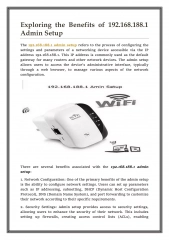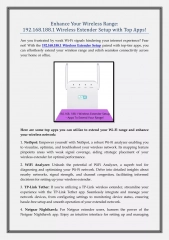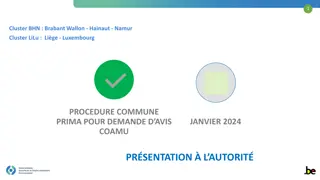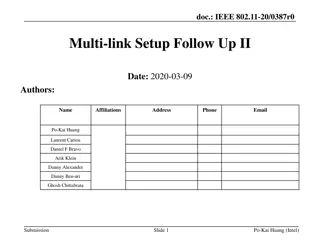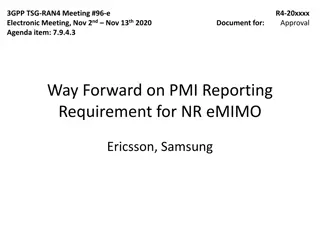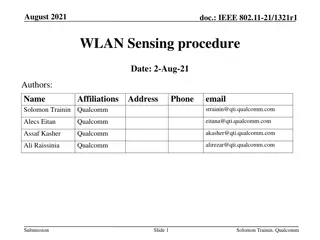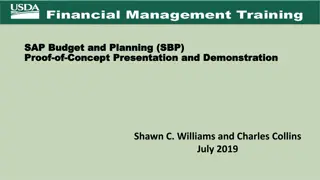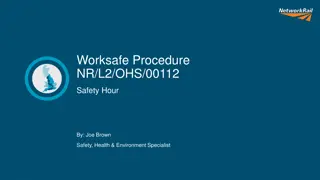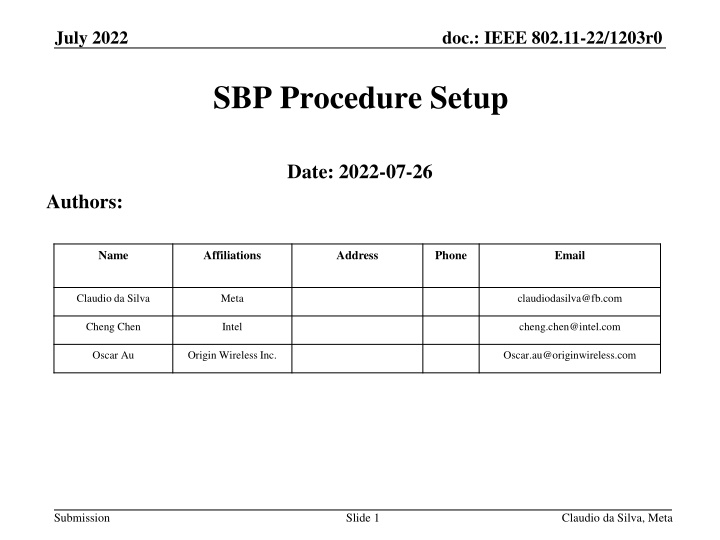
IEEE 802.11-22/1203r0 SBP Procedure Overview
This document provides an overview of the IEEE 802.11-22/1203r0 SBP (Sensing Basic Procedure) defined in July 2022. It covers the setup, WLAN sensing phases, reporting, and unresolved issues related to SBP initiator actions in WLAN sensing procedures. Feedback is sought for potential solutions to these pending items.
Download Presentation

Please find below an Image/Link to download the presentation.
The content on the website is provided AS IS for your information and personal use only. It may not be sold, licensed, or shared on other websites without obtaining consent from the author. If you encounter any issues during the download, it is possible that the publisher has removed the file from their server.
You are allowed to download the files provided on this website for personal or commercial use, subject to the condition that they are used lawfully. All files are the property of their respective owners.
The content on the website is provided AS IS for your information and personal use only. It may not be sold, licensed, or shared on other websites without obtaining consent from the author.
E N D
Presentation Transcript
doc.: IEEE 802.11-22/1203r0 July 2022 SBP Procedure Setup Date: 2022-07-26 Authors: Name Affiliations Address Phone Email Claudio da Silva Meta claudiodasilva@fb.com Cheng Chen Intel cheng.chen@intel.com Oscar Au Origin Wireless Inc. Oscar.au@originwireless.com Submission Slide 1 Claudio da Silva, Meta
doc.: IEEE 802.11-22/1203r0 July 2022 Background Basic framework of the SBP procedure is defined in D0.1. SBP is a procedure that allows a non-AP STA to request an AP to perform WLAN sensing on its behalf. It can be roughly divided into three phases SBP procedure setup: To establish an SBP procedure, the SBP initiator (non-AP STA) sends an SBP Request frame to an SBP responder (AP). WLAN sensing: An SBP responder that sends an SBP Response frame with status code SUCCESS should initiate a WLAN sensing procedure with one or more non-AP STAs using operational parameters derived from those indicated within the SBP Request frame that requested the SBP procedure. SBP procedure reporting (optional) Submission Slide 2 Claudio da Silva, Meta
doc.: IEEE 802.11-22/1203r0 July 2022 D0.2 Submission Slide 3 Claudio da Silva, Meta
doc.: IEEE 802.11-22/1203r0 July 2022 D0.2 Submission Slide 4 Claudio da Silva, Meta
doc.: IEEE 802.11-22/1203r0 July 2022 D0.2 Submission Slide 5 Claudio da Silva, Meta
doc.: IEEE 802.11-22/1203r0 July 2022 Problem Statement Currently, the following items are pending and need to be defined to complete the definition of the SBP procedure. How does the SBP initiator selects and requests sensing responders to be used in WLAN sensing procedures initiated by an SBP request? How does the SBP initiator requests operational attributes to be used in WLAN sensing procedures initiated by an SBP request? How does the SBP initiator signals its intent to participate in WLAN sensing procedures initiated by an SBP request? There are several CIDs on these topics, including: 47, 204, 276, 459, 493, 573, 576, 595, 596, 743. This contribution aims to seek feedback from the group, and converge, on possible answers/solutions to the above questions. Submission Slide 6 Claudio da Silva, Meta
doc.: IEEE 802.11-22/1203r0 July 2022 Sensing Responder Selection Two cases have been discussed so far in various contributions and email threads: Case 1: SBP initiator does not have a preferred list of STAs SBP initiator relies on the SBP responder to identify potential sensing responders. Note: SBP initiator may not even be aware of any other devices nearby except for the SBP responder AP it is associated with. Solution: The SBP initiator requests a number of sensing responders. Case 2: SBP initiator has a preferred list of STAs This could happen in a controlled or managed network (e.g., enterprise scenarios or retail stores) where devices can easily discover each other via some implementation specific means (app, cloud, etc.). List of preferred STAs is provided by SME (SBP initiator); the standard does not define a procedure to obtain preferred STA list. This case was discussed at a few contributions, for example, 22/0671r1. Solution: SBP initiator requests a desired sensing responder list to SBP responder. Preferred sensing responders are identified with MAC addresses Submission Slide 7 Claudio da Silva, Meta
doc.: IEEE 802.11-22/1203r0 July 2022 Illustration of Case 1 Illustration of Case 2 SBP request SBP response SBP Initiator (non-AP STA) SBP Initiator (non-AP STA) SBP Responder (AP) Sensing Initiator SBP Responder (AP) Sensing Initiator SBP Request includes Number of sensing responders 2) Operational parameters SBP Request includes Preferred sensing responder list 2) Operational parameters 1) 1) Example: STA1 s MAC address, STA4 s MAC address, 160 MHz Example: 3 sensing responders, 160 MHz STA1 STA1 160 MHz-capable 160 MHz-capable STA4 STA4 160 MHz-capable 160 MHz-capable STA3 STA3 STA2 STA2 160 MHz-capable 160 MHz-capable 80 MHz-capable 80 MHz-capable Sensing Responders Sensing Responders Submission Slide 8 Claudio da Silva, Meta
doc.: IEEE 802.11-22/1203r0 July 2022 Operational Parameters SBP Request frame includes requested operational parameters to be used in sensing measurement instances associated with an SBP request. The list of operational parameters could include, but possibly not limited to, the following items: SBP specific parameters: Number of sensing responders, whether SBP initiator participates in resulting SBP procedures. Conventional operational parameters: Role of sensing responders, PHY parameters Conventional operational parameters are those found in the Sensing Measurement Parameters element, which is included in the SBP Request frame. To keep complexity at bay, one set of operational parameters is defined in the SBP Request frame that applies to all sensing responders. Recall that SBP Response frame includes a single Measurement Setup ID. Submission Slide 9 Claudio da Silva, Meta
doc.: IEEE 802.11-22/1203r0 July 2022 SP 1 Do you agree with the following: SBP Request frame shall include One field used to request a total number of sensing responders One optional element that defines a Preferred Sensing Responder List used to indicate the identities of SBP initiator s preferred sensing responders The element includes a list of MAC addresses of the preferred sensing responders If the SBP responder accepts the SBP Request frame that includes a Preferred Responder List element, the SBP responder shall not initiate the corresponding WLAN sensing procedure with sensing responders that are not in the list. Submission Slide 10 Claudio da Silva, Meta
doc.: IEEE 802.11-22/1203r0 July 2022 SP2 Do you agree with the following: The SBP Request frame shall include one Sensing Measurement Parameters element, as defined in 9.4.2.317 (Sensing Measurement Parameters element), that is used to request operational parameters to be used in sensing measurement instances that result from the SBP request. The SBP Request frame may also include other SBP-specific operational parameter fields/elements, such as one used to indicate whether the SBP initiator requests to participate in the WLAN sensing procedure as a sensing responder. Submission Slide 11 Claudio da Silva, Meta

